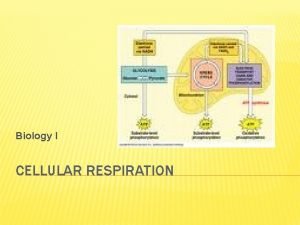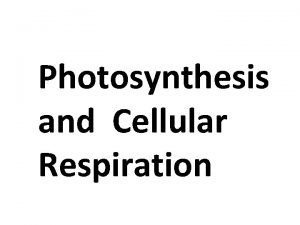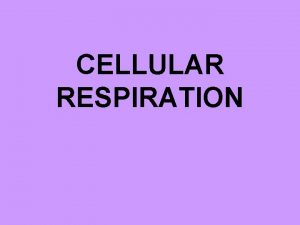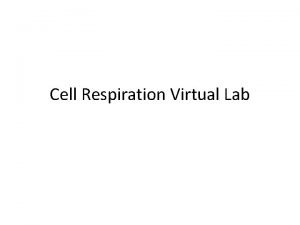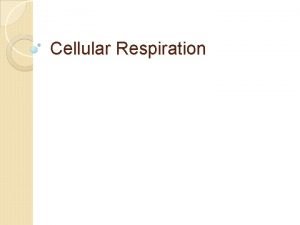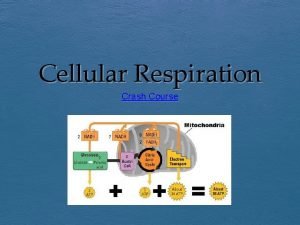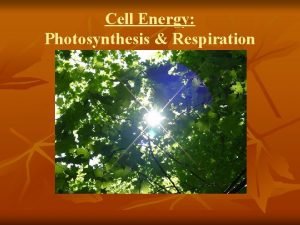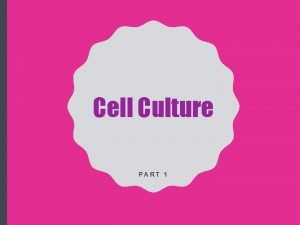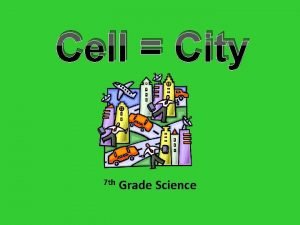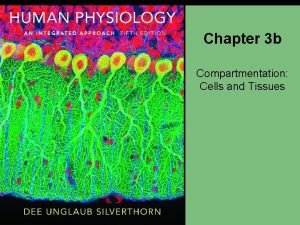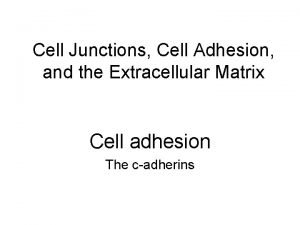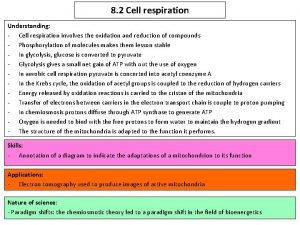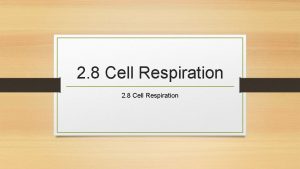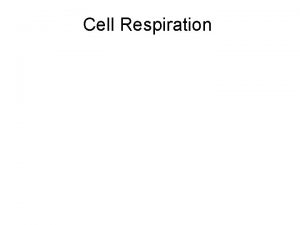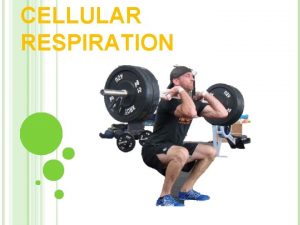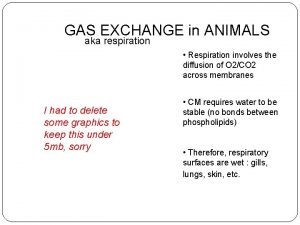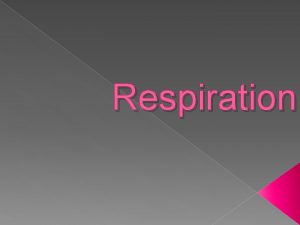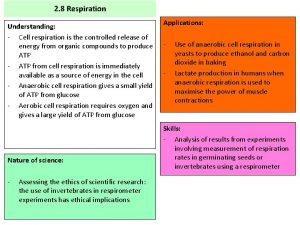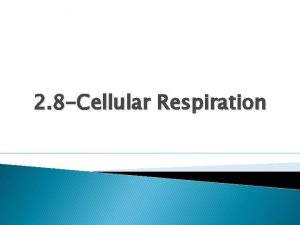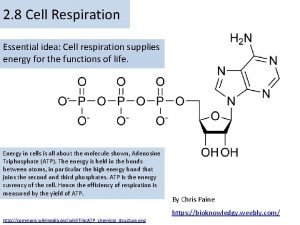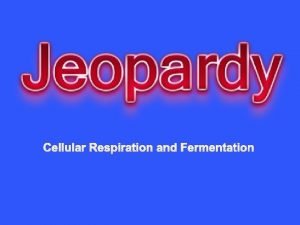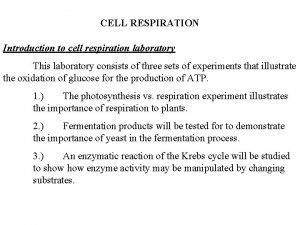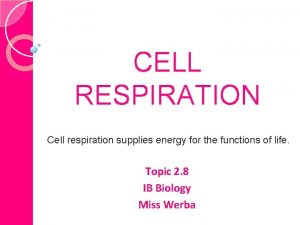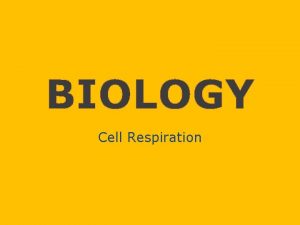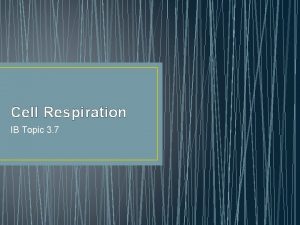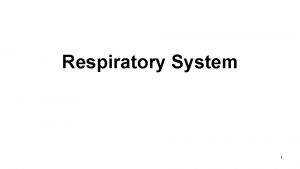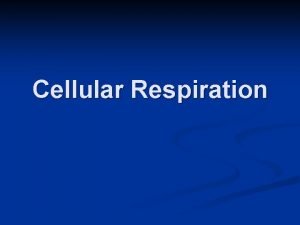8 2 Cell respiration Understanding Cell respiration involves











































- Slides: 43

8. 2 Cell respiration Understanding: - Cell respiration involves the oxidation and reduction of compounds Phosphorylation of molecules makes them lesson stable In glycolysis, glucose is converted to pyruvate Glycolysis gives a small net gain of ATP with out the use of oxygen In aerobic cell respiration pyruvate is concerted into acetyl coenzyme A In the Krebs cycle, the oxidation of acetyl groups is coupled to the reduction of hydrogen carriers Energy released by oxidation reactions is carried to the cristae of the mitochondria Transfer of electrons between carriers in the electron transport chain is couple to proton pumping In chemiosmosis protons diffuse through ATP synthase to generate ATP Oxygen is needed to bind with the free protons to form water to maintain the hydrogen gradient The structure of the mitochondria is adapted to the function it performs. Skills: - Annotation of a diagram to indicate the adaptations of a mitochondrion to its function Applications: - Electron tomography used to produce images of active mitochondria Nature of science: - Paradigm shifts: the chemiosmotic theory led to a paradigm shift in the field of bioenergetics

Draw a mitochondrion Inner membrane Outer membrane Cristae Matrix Inter membrane space Label each part Skills: Annotation of a diagram to indicate the adaptations of a mitochondrion to its function

Mitochondrion Drawing Skills: Annotation of a diagram to indicate the adaptations of a mitochondrion to its function

Electron Tomography Allows a 3 D image of mitochondria to be made Dr Carmen Mannella: - Cristae are not just infoldings but are defining micro-compartments in the organelle - Cristae are flexible and dynamic – change depending on the metabolism and other stimuli - Specific proteins/lipids that actively regulate the inner membrane Applications: Electron tomography used to produce images of active mitochondria

Electron Tomography Changes in internal organization of mitochondria associated with cell death and disease: (A) Normal, isolated liver mitochondrion (B) Liver mitochondrion treated with a protein that induces programmed cell death (C) Mitochondrion from a patient with a mitochondrial myopathy (causes muscle weakness)

Oxidation and Reduction Always occur together Involve transferring electrons from one thing to another Oxidation = loss of electrons Reduction = gain of electrons For something to gain an electron, something has to lose one. OIL RIG Understanding: - Cell respiration involves the oxidation and reduction of compounds

Oxidation and Reduction Understanding: - Cell respiration involves the oxidation and reduction of compounds

e. g. Benedict's test Copper sulphate solution contains copper ions – Cu 2+ This is a blue solution Mix in some sugar The sugar gives the Cu 2+ electrons which converts them into Copper atoms–Cu. This forms a red precipitate What had been oxidised? What has been reduced?

Electron Carriers • Electron carriers accept or give up electrons as required – linking oxidations and reductions in cells. • The main electron carrier in respiration is NAD+ (nicotinamide adenine dinucleotide) • Initially has a positive charge and exists normally as NAD+ What does it look like?

Reducing NAD 1. 2. 3. 4. Two hydrogen atoms removed from substance that is being oxidised? ! during respiration (see later) The first hydrogen is split into a proton and an electron NAD+ accepts the electron, and the proton (H+) is released NAD accepts the proton and electron of the second hydrogen atom Reduction can therefore be the gaining of hydrogen atoms Oxidation can be losing hydrogen atoms NAD+ + 2 H+ + 2 e- NADH + H+ NAD+ + 2 H NADH + H+ Oxidation can therefore be achieved by losing these Hydrogen atoms again Understanding: - Cell respiration involves the oxidation and reduction of compounds


Oxidation and reduction – describe what is happening below:

Phosphorylation Addition of a phosphate molecule to an organic molecule Make a molecule less stable – so more likely to react Reduces the activation energy required for reactions that follow – more likely to occur Understanding: - Phosphorylation of molecules makes them less stable

Phosphorylation Key area = production of ATP (ADP ATP) Understanding: - Phosphorylation of molecules makes them less stable

Oxidation/Reduction Phosphorylation

Respiration 1. Glycolysis 2. Link Reaction 3. Krebs cycle 4. Oxidative Phosphorylation • Electron transport chain • Chemiosmosis

Glycolysis Glucose (6 C) converted into pyruvate (two) (3 C) In the cytoplasm of the cell (outside of mitochondrion) Not a single step process – metabolic pathway 1 glucose 2 pyruvate Reduced NAD (NADH) made (has gained electrons) 4 H + Phosphorylation of ADP – overall 2 ATP produced Understanding: In glycolysis, glucose is converted to pyruvate Glycolysis gives a small net gain of ATP with out the use of oxygen In aerobic cell respiration pyruvate is concerted into acetyl coenzyme A (NADH) + 2 H+ + + 2 H

“Names of intermediate compounds in glycolysis are not required” A good example of a metabolic pathway

Glycolysis 1. 2. 3. 4. 5. 2 ATP used to phosphorylate one molecule of glucose Metabolic pathways lead to two molecules of triose phosphate Each is then oxidised Hydrogen is accepted by NAD+ to make NADH (reduced NAD) + H+ Phosphate group transferred to ADP to produce 2 ATP molecules and (two) pyruvate molecule Understanding: In glycolysis, glucose is converted to pyruvate Glycolysis gives a small net gain of ATP with out the use of oxygen 4 H + (NADH) + 2 H+

Outline the process of Glycolysis (5 marks) 1. 2. 3. 4. 5. 6. Occurs in the cytoplasm Glucose is phosphorylated using ATP Split (lysis) into two triose phosphates Oxidation of triose phosphates (two) NAD+ reduced to NADH (+ H+) Net gain of two ATP molecules/two ATP use and four ATP produced 7. (two) Pyruvate at the end of glycolysis

The Link Reaction In the mitochondrial matrix Two molecules of pyruvate produced in glycolysis per molecule of glucose. If oxygen is present (AEROBIC) – pyruvate absorbed into mitochondria where it is oxidised (lose hydrogen atoms). NAD+ is reduced forming NADH Pyruvate is decarboxylated (Decarboxylated = take away carboxyl group and forms CO 2) CO 2 removed to form an acetyl group (acetate). Acetyl group then joined to coenzyme A to make acetyl coenzyme A (Co. A) How many times does this happen per glucose molecule? ? Understanding: In aerobic cell respiration pyruvate is concerted into acetyl coenzyme A + (NADH) + 2 H+

The Link Reaction Link reaction - links glycolysis with the Krebs cycle Happens twice per glucose molecule because 2 x pyruvate are made Krebs Cycle

The Krebs Cycle 1. 2. Acetyl Co. A (2 C) from link reaction combines with a 4 carbon compound, making a 6 carbon compound. This is oxidized and decarboxylated to form a 5 carbon compound. Carbon is released and combines with oxygen to form carbon dioxide. NAD+ is reduced to NADH The Co. A goes back to be reused in the link reaction 1. + 2. + Understanding: In the Krebs cycle, the oxidation of acetyl groups is coupled to the reduction of hydrogen carriers Energy released by oxidation reactions is carried to the cristae of the mitochondria +

The Krebs Cycle 3. The 5 carbon compound is oxidized and decarboxylated to form a 4 carbon compound. This forms carbon dioxide and another NADH 4. The 4 carbon compound undergoes various changes resulting in more products: - FAD to FADH 2 - NAD to NADH - ADP to ATP + 4. + 3. + What is happening in these situations? Understanding: In the Krebs cycle, the oxidation of acetyl groups is coupled to the reduction of hydrogen carriers Energy released by oxidation reactions is carried to the cristae of the mitochondria

The Krebs Cycle Must spin twice for each glucose molecule as two pyruvates are formed in glycolysis. Every 1 glucose molecule (2 spins) produces: - 6 NADH (oxidation and reduction) of? - 4 CO 2 (decarboxylation) - 2 FADH 2 (oxidation and reduction) of? - 2 ATP (phosphorylation) Half of these per spin Substrate* phosphorylation – ATP produced Energy stored in NADH and FADH passed on to the final part of respiration: oxidative phosphorylation (electron transport chain) Understanding: - In the Krebs cycle, the oxidation of acetyl groups is coupled to the reduction of hydrogen carriers - Energy released by oxidation reactions is carried to the cristae of the mitochondria

The Krebs Cycle By the end of the Krebs cycle, only 4 ATPs have been gained. - 4 from glycolysis (but 2 used up in the process) - 2 from Krebs cycle All by substrate level phosphorylation* During respiration a total of 36 ATPs gained overall from 1 glucose molecule. (32 produced in the Electron transport chain and chemiosmosis) Understanding: - In the Krebs cycle, the oxidation of acetyl groups is coupled to the reduction of hydrogen carriers - Energy released by oxidation reactions is carried to the cristae of the mitochondria

Phosphorylation What we have seen so far Substrate level: ATP produced via transport of phosphate group directly to ADP Oxidative: Oxidative phosphorylation is the metabolic pathway in which cells use enzymes to oxidise compounds (reduced NAD and reduced FAD), thereby taking energy to the electon transport chain which is used to form ATP. Understanding: - Phosphorylation of molecules makes them less stable


Oxidative Phosphorylation - Electron Transport Chain Across the inner and Chemiosmosis membrane Series of small steps, carried out by a chain of electron carriers. Generates ATP with the energy from previous oxidation reactions* * FADH 2 also + Understanding: Transfer of electrons between carriers in the electron transport chain is couple to proton pumping In chemiosmosis protons diffuse through ATP synthase to generate ATP Oxygen is needed to bind with the free protons to form water to maintain the hydrogen gradient

Oxidative Phosphorylation - Electron Transport Chain Across the inner and Chemiosmosis membrane 1. 2. 3. 4. NADH is oxidised and releases 2 hydrogen atoms. NAD+ returns to matrix. Both H atoms split into H+ and e-. The electrons move down the electron transport chain via electron carriers (membrane proteins), losing energy at each one. This provides the carriers with energy to pump protons (H+) into the intermembrane space. A concentration gradient of proteins builds up. 4. 2. 1. FADH 2 also + 3.

Oxidative Phosphorylation - Electron Transport Chain Across the inner and Chemiosmosis membrane 5. In order for electrons to carry on flowing they must be transferred to a terminal electron acceptor – oxygen which becomes O 2 - (gets reduced), but then combines with two H+ (from the matrix) to form water. By using up H+ the proton gradient across the inner membrane is maintained 6. Protons pass from the intermembrane space, through ATP synthase, into the matrix. As they move down their concentration gradient, energy is released and used by ATP synthase to phosphorylate ADP to ATP. 5. FADH 2 also + 6. _

Draw a mitochondrion Inner membrane Outer membrane Cristae Matrix Inter membrane space What is the role of each part? Skills: Annotation of a diagram to indicate the adaptations of a mitochondrion to its function

Mitochondrion Functions Inner membrane – Electron transport chain and ATP synthase Outer membrane – Creates a cellular compartment Cristae – projections of inner membrane which increase surface area for oxidative phosphorylation Matrix – Contains enzymes for Krebs cycle and link reaction Inter membrane space - Protons pumped into space by electron transport chain. Small space means concentration builds up quickly Don’t worry. Will will look at all these metabolic processes Understanding: - The structure of the mitochondria is adapted to the function it performs.

How many ATP molecules are made from one glucose molecule?

How many ATP molecules are made from one glucose molecule?

Respiration Step 1: Mitochondria Step 2: Steps in respiration 1. 2. Step 3: 3. 4. 5. Step 4 & 5:

Create a respiration diagram Use a piece of A 3/A 4 paper Create a respiration diagram – go step by step from the start. Include: - Glycolysis Link reaction Krebs cycle Oxidative phosphorylation Electron transport chain Chemiosmosis - Where do they happen Is reduced NAD/FAD produced Is ATP produced What is made from that process What happens here Is it substrate level phosphorylation or oxidative phosphorylation


8 marks Explain the process of aerobic respiration including oxidative phosphorylation.

1. 2. 3. 4. 5. 6. 7. 8. 9. 10. 11. 12. 13. 14. 15. glucose converted to pyruvate (two molecules); by glycolysis; pyruvate enters the mitochondria; pyruvate converted to acetyl Co. A; by oxidation and decarboxylation / NADH and CO 2 formed; acetyl Co. A enter the Krebs cycle (by link reaction); FAD / NAD+ reduced to NADH / FADH 2; FADH 2 / NADH donates electrons to electron transport chain (reject donates H+); electrons release energy as they pass along the chain; oxygen final electron acceptor; production of water; builds up proton gradient/protons pumped across inner membrane; protons flow into matrix of mitochondria through ATPase / ATP synthase; ATP produced; produces 36 / 38 ATP (per glucose); 8 max Accept any appropriate terminology for NAD and FAD. (Plus up to [2] for quality)

Respirometers

Anaerobic Respiration • Does not use oxygen • Only gets as far as glycolysis • Produces lactate (lactic acid) + +2 ATP + • The production of lactate regenerates NAD+. This means glycolysis can continue • 2 ATP produced per glucose

Breakdown of lactic acid in animals • Cells convert the lactic acid back into pyruvate (which re-enters aerobic respiration when oxygen is present) • Liver cells can convert the lactic acid back into glucose (which can be respired or stored)
 External vs internal respiration
External vs internal respiration Internal vs external respiration
Internal vs external respiration Photosyntehsis equation
Photosyntehsis equation What's the equation for cellular respiration
What's the equation for cellular respiration Aerobic respiration
Aerobic respiration What is the word equation for cellular respiration
What is the word equation for cellular respiration Energy
Energy Lab 5 cell respiration
Lab 5 cell respiration What type of cell performs cellular respiration
What type of cell performs cellular respiration Photosynthesis and cellular respiration virtual lab
Photosynthesis and cellular respiration virtual lab Where in the cell does cellular respiration occur
Where in the cell does cellular respiration occur Cellular respiration formula
Cellular respiration formula Define respiration
Define respiration Chapter 6 cell energy photosynthesis and respiration
Chapter 6 cell energy photosynthesis and respiration Cell city analogy
Cell city analogy Denuding tower
Denuding tower Site:slidetodoc.com
Site:slidetodoc.com Prokaryotic and eukaryotic cells
Prokaryotic and eukaryotic cells Animal cell plant cell venn diagram
Animal cell plant cell venn diagram S
S Dry cell vs wet cell
Dry cell vs wet cell Animal cells and plant cells venn diagram
Animal cells and plant cells venn diagram Cell wall function
Cell wall function Plant cell structure
Plant cell structure Animal cell structures
Animal cell structures Carbohydrate in cell membrane
Carbohydrate in cell membrane Morphology of cells in culture
Morphology of cells in culture Cell line vs cell strain
Cell line vs cell strain Cell city project animal cell
Cell city project animal cell Primary cell and secondary cell
Primary cell and secondary cell Whats the difference between plant and animal cells
Whats the difference between plant and animal cells Cell-cell junction
Cell-cell junction Cell-cell junction
Cell-cell junction What cell organelle is like lysol spray cleaning the cell
What cell organelle is like lysol spray cleaning the cell Events of the cell cycle
Events of the cell cycle Prokaryotic cell and eukaryotic cell
Prokaryotic cell and eukaryotic cell Eukaryotic cell animal cell
Eukaryotic cell animal cell The scientist mathias schleiden studied _______ in ______.
The scientist mathias schleiden studied _______ in ______. Parts of a cell graphic organizer
Parts of a cell graphic organizer Idealized animal cell
Idealized animal cell Walker cell and hadley cell
Walker cell and hadley cell Prokaryotic vs eukaryotic transcription worksheet
Prokaryotic vs eukaryotic transcription worksheet Cell cycle and cell division
Cell cycle and cell division Biology.arizona.edu/cell bio/activities/cell cycle/01.html
Biology.arizona.edu/cell bio/activities/cell cycle/01.html





